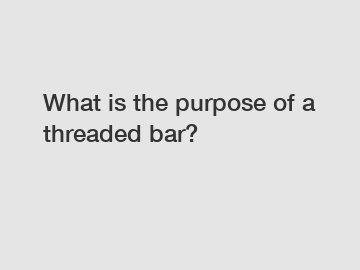Feb. 05, 2024
Construction
What is the Purpose of a Threaded Bar?
When it comes to construction and engineering projects, a threaded bar is a commonly used component. Also known as a threaded rod or stud, it is a long, straight bar that has threading on both ends. Threaded bars play a crucial role in various applications, ranging from structural support to fastening and joining different types of materials together. In this article, we will explore the purpose of a threaded bar and its importance in different industries.
Structural Support in Construction:

One primary purpose of a threaded bar is to provide structural support in construction projects. Threaded bars are often used as reinforcements in concrete structures, such as buildings, bridges, and retaining walls. By embedding the threaded bar within the concrete, it helps to distribute the load and enhance the overall strength of the structure. The threaded bar's ability to withstand tension makes it an ideal choice for this application.
Fastening and Joining Materials:
Threaded bars also serve the purpose of fastening and joining different materials together. The threading on the bar allows for the attachment of nuts, washers, and other fasteners. This enables the threaded bar to securely connect various components, such as beams, brackets, and base plates. The threaded bar's versatility makes it an essential element in building frameworks, machine assemblies, and even furniture manufacturing.
Adjustability and Customization:
The threaded bar's design offers adjustability and customization options, adding to its overall purpose. Many threaded bars come in standard lengths but can be easily cut to the desired size using a cutting tool. This allows engineers and builders to tailor the length of the bar according to their specific requirements. Additionally, threaded bars can be easily modified by cutting new threading or adding additional fasteners, providing flexibility in various applications.
Anchor Systems:
Another crucial purpose of a threaded bar is in anchor systems. Threaded bars are commonly used in applications where strong anchoring is required, such as in industrial equipment, heavy machinery, and seismic retrofitting. The threaded bar is embedded into the material, typically concrete, and secured with epoxy or other adhesives. This provides a reliable and sturdy anchor point for attaching heavy loads and structural components.
Tie Rods and Tension Bars:
Threaded bars are extensively used as tie rods and tension bars in various civil engineering projects. Tie rods are used to counteract forces that may cause structures to fail, such as shear forces or wind loads. These rods are installed to stabilize the structure and prevent it from collapsing under extreme conditions. Tension bars, on the other hand, are utilized to provide resistance against bending or deflection. Both tie rods and tension bars rely on the strength and durability of threaded bars to ensure structural integrity.
Conclusion:
In conclusion, threaded bars play a crucial role in construction and engineering projects. Whether it is for structural support, fastening and joining materials, adjustability, anchor systems, or tie rods and tension bars, threaded bars offer versatility, strength, and reliability. They provide solutions for different industries and applications, ensuring the safety and stability of structures and components. If you require threaded bars for your projects, contact us to find the right product for your needs.
Contact us today for all your threaded bar requirements and let our experts assist you in finding the perfect solution for your project.
Want more information on thread bar durability, the thread bar manufacturer, thread bar accessories? Feel free to contact us.
Previous: When should you use an aluminum screen?
Next: Which Custom Hand Carved Water Fountain Design Reflects Your Personality?
If you are interested in sending in a Guest Blogger Submission,welcome to write for us!
All Comments ( 0 )